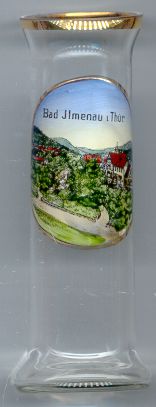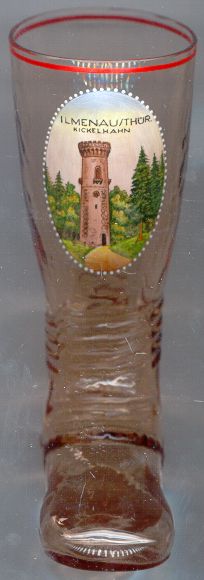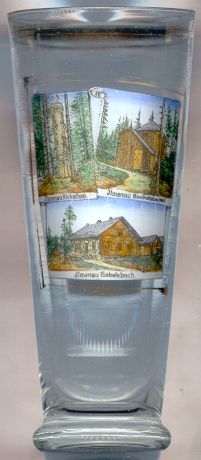

|
| DEUTSCHLAND | GERMANY |
| Bundesland: Freistaat Thüringen | Thuringia |
| Landkreis: Ilm-Kreis |
 Ilmenau is situated at an elevation of 500 m in the Ilm valley at the northern slopes of the Thüringer Wald mountain region.
Founded most likely in the 13th century, it was first mentioned in documents of the 14th century. By 1341 it had obtained the status of a town.
Since 1660/1661 Ilmenau belonged to the Duchy (1815 Grand Duchy) Saxe-Weimar(-Eisenach).
Mining for silver and copper propably began already in the 13th century, but had declined by 1739.
The famous German poet, naturalist and politician Johann Wolfgang von Goethe was sent to Ilmenau in 1776 by the Weimar court in order to
reform the obscure financial administration of Ilmenau. Goethe also furthered the mining activities in the area. In total, Goethe visited Ilmenau
28 times. During one of his visits, in 1780, he wrote one of his most famous poems, "Wandrers Nachtlied" (Wanderer's Night Song),
during an excursion onto the Kickelhahn mountain (861 m) near Ilmenau. In 1675, the first glassworks factory was opened.
Porcellain manufactures followed in the 18th century. The tradition of Ilmenau as a cold-water spa began in 1838, but the increasing industrialisation
and a large fire, which destroyed the spa facilities, ended this tradition in 1920.
The Thuringian Technikum Ilmenau was founded in 1894. The school became a technical college in 1953, and a technical university in 1992.
Ilmenau is situated at an elevation of 500 m in the Ilm valley at the northern slopes of the Thüringer Wald mountain region.
Founded most likely in the 13th century, it was first mentioned in documents of the 14th century. By 1341 it had obtained the status of a town.
Since 1660/1661 Ilmenau belonged to the Duchy (1815 Grand Duchy) Saxe-Weimar(-Eisenach).
Mining for silver and copper propably began already in the 13th century, but had declined by 1739.
The famous German poet, naturalist and politician Johann Wolfgang von Goethe was sent to Ilmenau in 1776 by the Weimar court in order to
reform the obscure financial administration of Ilmenau. Goethe also furthered the mining activities in the area. In total, Goethe visited Ilmenau
28 times. During one of his visits, in 1780, he wrote one of his most famous poems, "Wandrers Nachtlied" (Wanderer's Night Song),
during an excursion onto the Kickelhahn mountain (861 m) near Ilmenau. In 1675, the first glassworks factory was opened.
Porcellain manufactures followed in the 18th century. The tradition of Ilmenau as a cold-water spa began in 1838, but the increasing industrialisation
and a large fire, which destroyed the spa facilities, ended this tradition in 1920.
The Thuringian Technikum Ilmenau was founded in 1894. The school became a technical college in 1953, and a technical university in 1992.


The  lookout tower [right, no. 660; and left, no. 2064: top left picture] on the Kickelhahn mountain did not exist when Goethe visited this place.
Grand Duchess Maria Pawlowna, wife of Hereditary Prince Carl Friedrich of Saxe-Weimar-Eisenach, suggested to build such a tower when she came here
in 1852. Two years later it was completed. Its height is 24 m, 107 steps lead up to the platform.
lookout tower [right, no. 660; and left, no. 2064: top left picture] on the Kickelhahn mountain did not exist when Goethe visited this place.
Grand Duchess Maria Pawlowna, wife of Hereditary Prince Carl Friedrich of Saxe-Weimar-Eisenach, suggested to build such a tower when she came here
in 1852. Two years later it was completed. Its height is 24 m, 107 steps lead up to the platform.
The  Goethehäuschen (Goethe's Cabin) [left, no. 2064: top right picture]
was built in 1783 on the Kickelhahn, only a few metres from its summit, as a hunting shed for Duke (1815 Grand Duke) Carl August of Saxe-Weimar-Eisenach.
In the night from 5th to 6th September 1783 Johann Wolfgang von Goethe jotted down his famous poem Wandrers Nachtlied – Ein Gleiches („über allen Gipfeln ist Ruh'...”)
on a wooden panel above one of the windows of the shed.
Goethehäuschen (Goethe's Cabin) [left, no. 2064: top right picture]
was built in 1783 on the Kickelhahn, only a few metres from its summit, as a hunting shed for Duke (1815 Grand Duke) Carl August of Saxe-Weimar-Eisenach.
In the night from 5th to 6th September 1783 Johann Wolfgang von Goethe jotted down his famous poem Wandrers Nachtlied – Ein Gleiches („über allen Gipfeln ist Ruh'...”)
on a wooden panel above one of the windows of the shed.
The  Gabelbach-Häuschen (Gabelbach House) [left, no. 2064: bottom picture] is located southeast of the Kickelhahn.
It once belonged to the "Gemeinde Gabelbach", a local club of hobby poets.
Gabelbach-Häuschen (Gabelbach House) [left, no. 2064: bottom picture] is located southeast of the Kickelhahn.
It once belonged to the "Gemeinde Gabelbach", a local club of hobby poets.
[https://de.wikipedia.org/wiki/Kickelhahn; http://woerterbuchnetz.de/Meyers/?sigle=Meyers&mode=Vernetzung&hitlist=&patternlist=&lemid=II00505; http://www.deutsche-schutzgebiete.de/ilmenau.htm]
![[scale]](lineal.jpg)